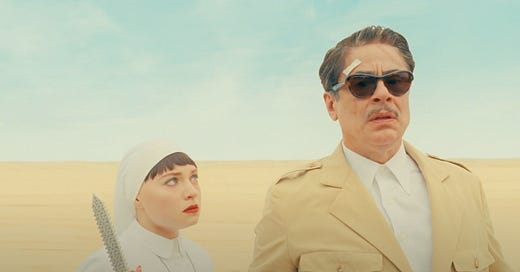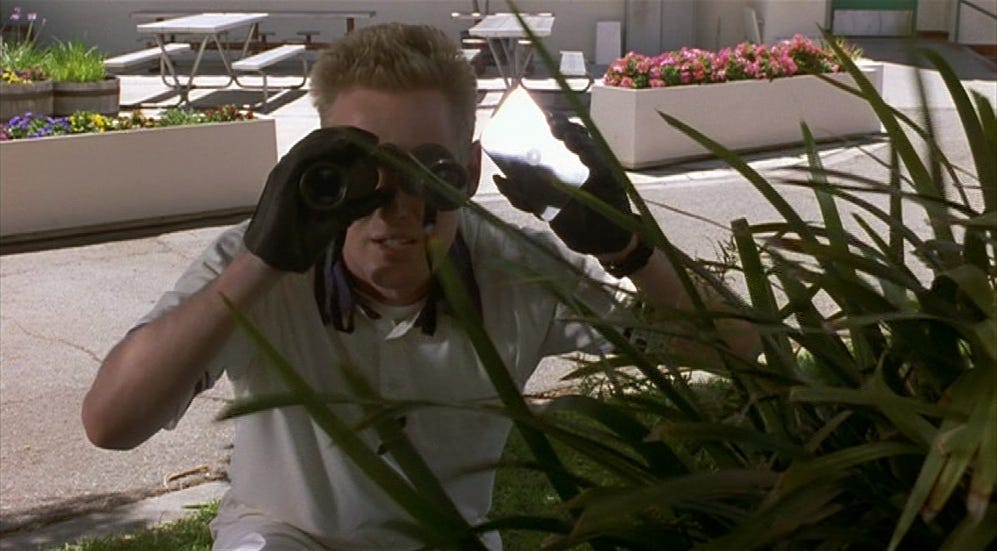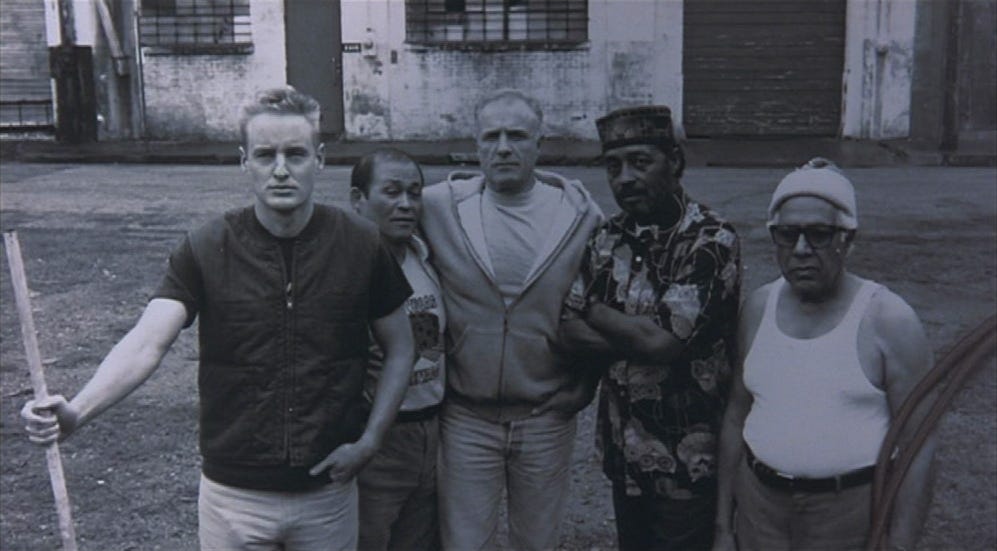What you are about to read is less a review than a journey from resistance to acceptance to devotion. It took me three screenings to get to the bottom of my changing and overlapping feelings about Wes Anderson’s latest film. And then I took my kids. Good thing I have a Regal Unlimited Pass or I’d be broke by now!
Screening #1
The sound of gunfire startled me awake. Where was I? Was I under attack? No, thank goodness I was safe in the center of the third row of my local Regal movie theatre. Welcome back to The Phoenician Scheme, Alan!
Now, it’s not entirely Wes’s fault that I fell asleep, I had had a big day with work and the kids, made dinner and got them to bed, then was off to see a 10:40 PM showing, which didn’t get the movie playing until well after 11. I would also like to point out that I regularly fall asleep during many of my favorite movies, including Blade Runner and Apocalypse Now, so he’s in good company.
To quote Asteroid City, his last movie, “You can’t wake up if you don’t fall asleep.”
But still, despite a visual density and thick plot, there was not much in the “Scheme” that I could grab onto and make sense of what I was seeing. There were some hilarious moments in the opening scenes, which gave me hope, and a stunning slow-motion God’s-eye view bathtub credits shot complete with cooling Champagne in a bidet, but no character that I could relate to or a thread that I cared to follow.
We found ourselves going from plane crashes to Heaven, only to be back on earth, then an estranged daughter showed up, who is now a novice nun, and people are constantly trying to assassinate the main character, Zsa Zsa Somethingorother. And like Royal Tenenbaum, Stephen Zizou, Herman Blume, and countless other Andersonians, he’s been an absent father. I was trapped in a memetic echo chamber. Can I go off-script, please?
This must be what it is like to experience dementia. I can clearly recognize elements of the action in front of me, but it makes no sense. Who are all these people? Why does Scott Pilgrim have a funny accent?
Looks like I’ll have to see this one again. I do believe in Wes, even if I don’t like all his movies.
…a week goes by…
OK, I went to see it again. It kept gnawing on me that I had fallen asleep, and I really didn’t want to write a review of Act One alone. In my second viewing, I realized that I hadn’t even made it to the first turning point!
There is much to enjoy about the film as a whole, comedy works on many levels throughout the film, and the A-list cast is great, but they seem a bit aimless. The set design is predictably perfect, the carpets match the drapes, and the shots are slyly symmetrical. But there is something fundamental missing from this picture.
What was it that the Tin Man wanted? Oh yeah, a heart.
But a heart also needs blood, which is sorely missing. Even after my second viewing, I really couldn’t tell you what this movie is about or why it exists. Everyone is so cartoonish that I don’t care what they want; the plot is so convoluted that I didn’t know what to predict or how to react once something happened.
Apparently, they need some percentage of gap funding for a project once the price of rivets goes up (stylized corporate espionage!), and they try to get funding from a bunch of different wacky characters. Zsa Zsa finally finds out who has been trying to kill him all these years, but it didn’t mean much to me by that point.
And, what the hell is the titular scheme, anyway? I still can’t tell you. Is that the point? Or am I stupid? Not sure.
Stylization is great in filmmaking, but it can’t supersede the connection to the character. In earlier films, Anderson gets this balance right by digging into his protagonists and letting them feel like real people, even if exaggerated. I can connect to Max Fischer in Rushmore because I, too, have hosted many unrealistic dreams that I’ve tried to turn into reality, with varying results. The boy in Moonrise Kingdom has a preternatural confidence that I would have cherished as a kid. The lobby boy from the hotel movie reminds me of my early days trying to please when I was starting in the film business. Maybe his movies work best when viewed through a child’s lens.
Not one of the actors is at fault here. They just don’t have much to do. And Anderson takes a lackadaisical approach to the movie as a whole, which leaves it feeling episodic even as it adds up to pieces that are somehow smaller than the whole.
Maybe I’ll find this movie growing on me over the years, like so many other films I didn’t enjoy at first. But it sure feels like the maps have taken over from the territory. The signifier is more important than the signified. Maybe I could write a whole essay about the post-modern semiotic display here, but I’ll leave that for the academics.
Again, I truly enjoy Anderson’s films for the most part, but they need to have a stronger connection to humanity for me to fully embrace them. Meat puppets don’t get me to reevaluate my feelings. Style doesn’t make me question a fact. Art for art’s sake is a lie.
Why do we watch movies in the first place? To kill time? Sure, sometimes. To make out? Of course. But more often than not, we want to connect to other lived experiences. We want to know what else is out there. Anderson’s films have been making it harder to get to the core of that eternal question - how does it feel to be alive right now?
Instead, he seems to be asking, How does it feel to live inside a cartoon?
Then again, we are living in cartoonish times.
Screening #3
Three days later, I decided to give it another go. It kept burrowing into my brain over the past couple of days, funny little moments, the soundtrack, snippets of dialogue haunting me.
The third viewing finally came together for me, wrapping me like a warm blanket on a cold desert night. I found my way through the density of jokes. I forgave the rudimentary “plot” that felt so boring on earlier viewings. I came to enjoy the riches to rags story of Zsa-zsa and how he was saved by his daughter.
I don’t know why I was so confused by the plot in earlier viewings - it was more straightforward than I had remembered. And once I had gotten that down, I just enjoyed the millions of details that were layered into each shot.
I also started to see it as a meditation on a Donald Trump-like, larger-than-life character study about someone who has it all but comes to find that he has nothing, until he gives it all up for something and lets others take the glory so that he can finally be happy. Zsa-zsa, like Trump, had an abusive father who starved him of attention or love, so he has spent his life building a preposterous Rube Goldberg machine of a business plan. Everything he does is a desperate attempt to fill an empty void that can never be filled by earthly accomplishments. Capitalism at its finest.
What initially turned me off - the lack of emotion - turned out to be my favorite aspect of the movie. Zsa-zsa is introduced as a world-changing autocrat in a mausoleum mansion, inhabiting a space that is wildly out of proportion to necessity, but he ends up running a restaurant in a comically small Parisian side-street café. A gentle reminder that you can’t change the world if you can’t change yourself first.
Screening #4
I thought I was going to take my kids to see How to Train Your Dragon, but I forgot that they had self-respect. “I don’t want to ruin my childhood,” replied my nearly 14-year-old daughter, who grew up loving the animated original. She opted for The Phoenician Scheme instead, so I took along the 10-year-old for good measure, as she had enjoyed a lot of Asteroid City.
Unlike me, my daughters loved it from the get-go (although I had primed their reaction with tales of my cartoonish journey to acceptance). My older one also liked the simplicity of the plot, telling me that she loved nesting doll stories and enjoyed the ridiculous accent that Michael Cera puts on for most of the film.
Another aspect that grew on me with each viewing was my love of the soundtrack, a mix of Stravinsky’s finest with original “spy soundtrack” vibes from Alexandre Desplat. After the screening, I went to vote for mayor. Listening to the theme as I walked towards the polling place gave me a sense of the enormity of the consequences our smallest actions can add up to big results.
I still feel like Anderson could have done a better job of setting up the cartoonish stylization from the get-go, so it doesn’t feel as out of place in the end fight sequences, but this is definitely a case of familiarity breeding love rather than contempt. And as that’s the theme of the movie, when you dig down to it, I guess it’s the way I had to come around to the scheme.
From the 95-Year Plan to The Phoenician Scheme
To prepare for the Phoenicians, I checked out Anderson’s first film, Bottle Rocket, from the library. I had watched it a few times over the years, but had never fully connected to the film. This time, I didn’t watch to enjoy but to examine the Wesness. What was there from the beginning that made him stand out? What are the through-lines of his career?
Plots are important, but what makes a movie work is character. Can you imagine the detective genre without grumpy Humphrey Bogart snooping around?
My favorite exchange from The Big Sleep: “How do you like your whiskey?”
“In a glass.”
The Coen Brothers’ Fargo works because of how Marge Gunderson balances the criminal sleaze with a disarmingly positive attitude and heart.
In Bottle Rocket, the characters grab you from the opening frames. Luke Wilson’s Anthony is checking out of his voluntary mental hospital stay by throwing a bed sheet rope out the window. He could walk out the front door, but doesn’t want to disappoint his best friend Dignan’s escape plan fantasy (played by Owen Wilson). This is the perfect start to a heist film where everyone is lying and pretending, getting caught up in their fantasies.
Right off the bat, I’m hooked. Where will this lead? A grand plan to rob a bookstore! That’s where the money’s at. The film has many flaws in terms of pacing and gets lost in the middle, but Anderson showed an understanding of what draws us into a work. We see the earliest attention to detail with unexpected props, like a yellow jumpsuit that draws attention to itself while blending in at the same time.
Early examples of his visual style seen here: attention to detail - the overhead shots of plans and props a la classic heist films, a deliberate mix of composed formal shots and handheld, wacky outfits, ending with the main character in a thoughtful self-reflective moment that speed-ramps into slow motion.
I had heard whispers about this film in the mid-90s, but never saw it, so my introduction to Wes’s work was Rushmore, which I saw with my aunt and uncle in Berkeley. That film I liked from the start. It’s even further along the visual semiotic path, but still fresh and unexpected angles come and go. Each shot has purpose, and the story is much tighter, but with ebbs and flows to mimic the feeling of an academic calendar. It was also great to see Bill Murray in something again; it had been a few years since Groundhog Day.
Little did I know the celebrity tropes that were coming our way.














